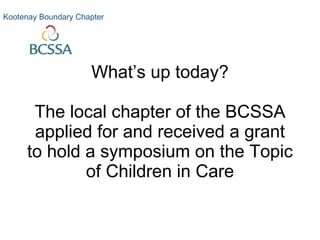Supporting Children In Care
- 1. Supporting Children in Care Kootenay Boundary Chapter
- 2. What’s the Issue? Kootenay Boundary Chapter
- 3. Simple Graduation rate in BC = 79% Graduation rate of Children in Care = 20% Kootenay Boundary Chapter
- 4. What’s the Issue? Graduation rate of Children in the home of a relative = 30% Kootenay Boundary Chapter
- 5. What’s the Issue? Percent of children in care who are not ready for kindergarten = 50% Kootenay Boundary Chapter
- 6. What’s the Issue? Do we know who are our Children in Care? Kootenay Boundary Chapter
- 7. What’s the Issue? Are we doing the best we can for them? Kootenay Boundary Chapter
- 8. What’s up today? The local chapter of the BCSSA applied for and received a grant to hold a symposium on the Topic of Children in Care Kootenay Boundary Chapter
- 9. We wanted to bring together the professionals who are involved in supporting children in care: Kootenay Boundary Chapter
- 10. Our goals: provide a forum for regional dialogue raise awareness of the needs of children in care enhance communications between all parties share successful strategies set the stage for followup Kootenay Boundary Chapter
- 11. Our goals: recognize that there will be significant staff change in the next five years and design structures that cope with the changes Kootenay Boundary Chapter
- 12. District Staff School administrators Counsellors Child Care workers Social Workers Kootenay Boundary Chapter
- 13. CYSN Provincial Direction A Framework for Action Kootenay Boundary Chapter
- 14. CYSN: Children and youth between birth and 19 who required additional educational, medical/health and social/environmental support, beyond that required by children in general, to enhance or improve their health, development, quality of life, and community integration. Kootenay Boundary Chapter
- 15. Prevalence Special Needs 10 – 15% Mental Health Issues 15% Significant Special Needs 5.65% Special Learning Disability 7% Kootenay Boundary Chapter
- 16. Services: 90 programs mostly by 3 Ministries Children and Family Education Health total spending: $525 + million Kootenay Boundary Chapter
- 17. Challenges: Waits, gaps and Overlaps Inconsistent Standards Complex and Disjointed Service System Kootenay Boundary Chapter
- 18. Common Vision Needed: Optimal development, health, well-being and achievement for children and youth with special needs. Kootenay Boundary Chapter
- 19. Common Mission Needed: To promote and deliver accessible, quality intervention and support services for children and youth with special needs and their families through an integrated service delivery model. Kootenay Boundary Chapter
- 20. Six supporting Strategies for Action: 1. Placing Children’s and families’ Needs First: Functionally-based and accessible services. Kootenay Boundary Chapter
- 21. Six supporting Strategies for Action: 2. Supporting our People: Training, Recruitment and Retention. Kootenay Boundary Chapter
- 22. Six supporting Strategies for Action: 3. Ensuring Quality and Performance: Improving quality measurement and accountability. Kootenay Boundary Chapter
- 23. Six supporting Strategies for Action: 4. Building and Using the Evidence Base: Promoting evaluation and research. Kootenay Boundary Chapter
- 24. Six supporting Strategies for Action: 5. Simplifying the Pathway to Services: Providers, agencies and ministries coordinating, collaborating and integrating more. Kootenay Boundary Chapter
- 25. Six supporting Strategies for Action: 6. Planning Together: Instituting a province-wide integrated planning mechanism. Kootenay Boundary Chapter
- 26. Now What? The problem is simple The solution is the complex piece Kootenay Boundary Chapter
- 27. People with a Vision Outperform their Resources  Joel Barker Kootenay Boundary Chapter
- 28. It's not the haves and the have nots It's the did and did nots! Kootenay Boundary Chapter
- 29. Let’s be a group of doers Thank you Kootenay Boundary Chapter
- 30. We gratefully acknowledge the financial support of the Province of British Columbia through the Ministry of Education Kootenay Boundary Chapter






























